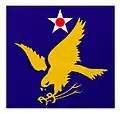878th Bombardment Squadron
The 878th Bombardment Squadron is a former United States Army Air Forces unit. It was activated in November 1943, equipped with Boeing B-29 Superfortress bombers, and assigned to the 499th Bombardment Group. After training in the United States, it deployed to Saipan, where it participated in the strategic bombing campaign against Japan, earning two Distinguished Unit Citations. After V-J Day, it returned to the United States, where it was inactivated at March Field, California on 16 February 1946.
| 878th Bombardment Squadron | |
|---|---|
 499th Group B-29 Superfortress over Mount Fuji in 1945 | |
| Active | 1943-1946 |
| Country | |
| Branch | |
| Role | heavy bomber |
| Engagements | Pacific Ocean Theater of World War II |
| Decorations | Distinguished Unit Citation |
| Insignia | |
| 878th Bombardment Squadron emblem (approved 8 September 1945)[1] |  |
History
The squadron was activated at Davis-Monthan Field, Arizona in November 1943 as one of the original four squadrons of the 499th Bombardment Group. Ten days later, a cadre moved to Smoky Hill Army Air Field, Kansas to begin Boeing B-29 Superfortress very heavy bomber training. The 878th trained in Kansas with early model B-29s, with frequent delays in training due to modifications of the aircraft correcting production deficiencies. When training was completed. the squadron moved to its combat base, Isely Field, Saipan, in the Mariana Islands in July 1944.[1][2]
The squadron did not arrive at its combat station until September 1944.[1] The squadron's first missions were flown against targets on Iwo Jima and Truk Island. On 24 November 1944, the squadron participated in the first raid on Japan by bombers based in the Mariana Islands. The squadron initially engaged in high altitude daylight attacks against industrial targets in Japan, It was awarded a Distinguished Unit Citation (DUC) for an attack on the Mitsubishi engine manufacturing plant in Nagoya on 23 January 1945.[2]
In March 1945, the tactics of Twentieth Air Force changed and the squadron began flying low level night attacks with incendiaries against area targets. The squadron was diverted from strategic operations when it conducted a series of raids on airfields in Kyushu to support Operation Iceberg, the landings on Okinawa in April 1945. The squadron earned a second DUC for this support. The squadron also dropped propaganda leaflets in enemy territory. After V-J Day, the squadron dropped food and supplies to Allied prisoners of war. It remained on Saipan until November and reassembled at March Field, California, where it was inactivated in February 1946.[1][2]
Lineage
- Constituted as the 878th Bombardment Squadron, Very Heavy on 19 November 1943
- Activated on 20 November 1943
- Inactivated on 16 February 1946[1]
Assignments
- 499th Bombardment Group, 20 November 1943 – 16 February 1946[1]
Stations
|
|
Aircraft
- Boeing B-17 Flying Fortress, 1944
- Boeing B-29 Superfortress, 1944–1946[1]
Awards and campaigns
| Award streamer | Award | Dates | Notes |
|---|---|---|---|
| Distinguished Unit Citation | 23 January 1945 | Nagoya, Japan, 878th Bombardment Squadron[1] | |
| Distinguished Unit Citation | 22–28 April 1945 | Japan, 878th Bombardment Squadron[1] |
| Campaign Streamer | Campaign | Dates | Notes |
|---|---|---|---|
| Air Offensive, Japan | 22 September 1944–2 September 1945 | 878th Bombardment Squadron[1] | |
| Western Pacific | 17 April 1945–2 September 1945 | 878th Bombardment Squadron[1] |
See also
References
Notes
- Maurer, Combat Squadrons, p. 795
- Maurer, Combat Units, pp. 565-566
Bibliography
![]() This article incorporates public domain material from the Air Force Historical Research Agency website http://www.afhra.af.mil/.
This article incorporates public domain material from the Air Force Historical Research Agency website http://www.afhra.af.mil/.
- Maurer, Maurer, ed. (1983) [1961]. Air Force Combat Units of World War II (PDF) (reprint ed.). Washington, DC: Office of Air Force History. ISBN 0-912799-02-1. LCCN 61060979. Retrieved 17 December 2016.
- Maurer, Maurer, ed. (1982) [1969]. Combat Squadrons of the Air Force, World War II (PDF) (reprint ed.). Washington, DC: Office of Air Force History. ISBN 0-405-12194-6. LCCN 70605402. OCLC 72556. Retrieved 17 December 2016.
- Salmons, Harold Irvin Jr. "Crew History," post-war scrap book, circa 1947.
.png.webp)
